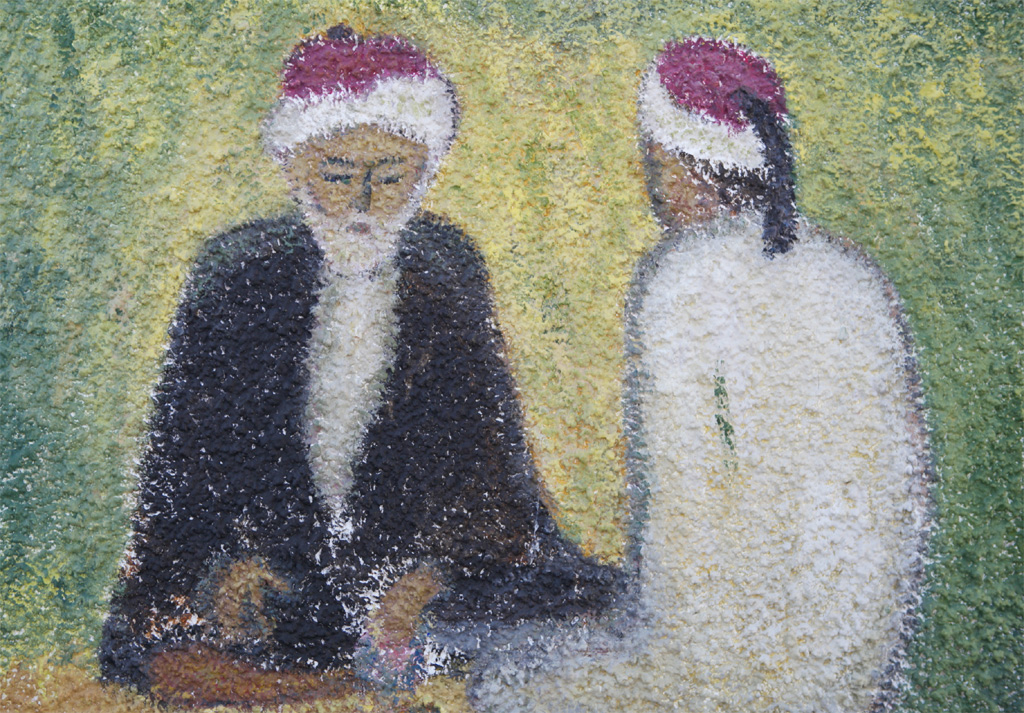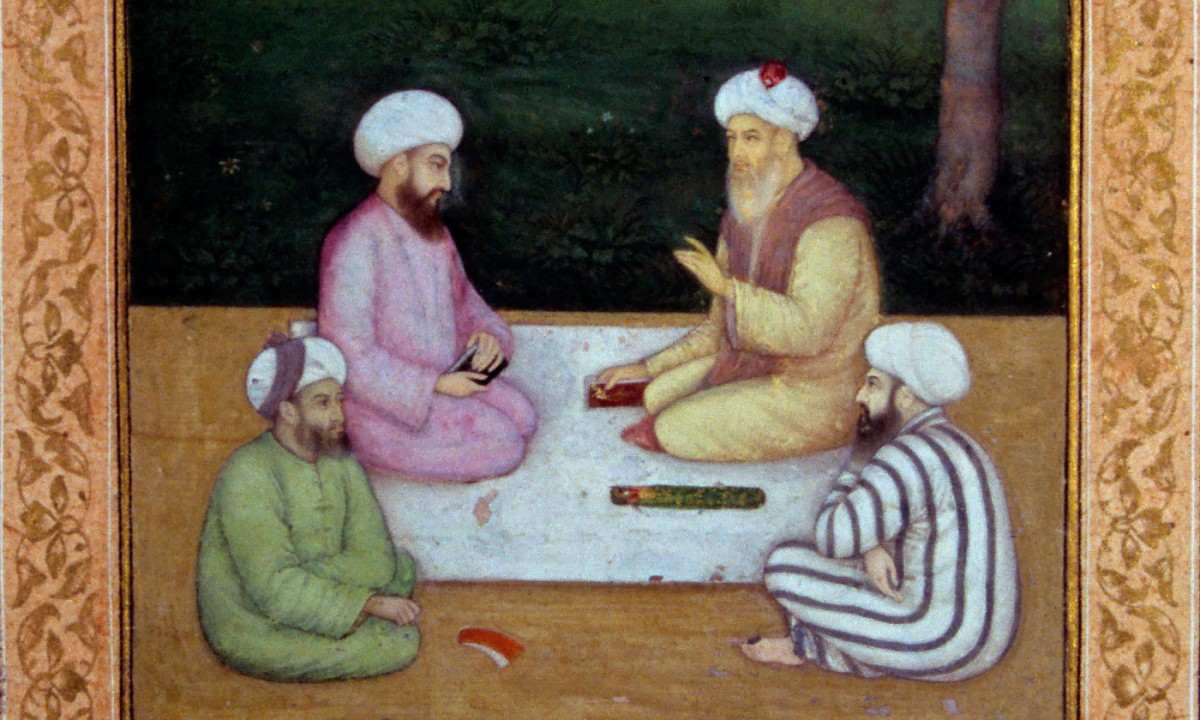“A spiritual mentor should not instruct his disciple openly but should use hints and suggestions to bring about change in his thought and behavior.”
— Hazrat Nizamuddin Auliya
This profound phrase captures the heart of the mentor-mentee connection between Hazrat Nizamuddin Auliya, the famed Sufi saint, and Amir Khusro, the illustrious poet and musician. Their friendship, marked by deep spiritual direction, artistic inspiration, and a deep relationship of respect, provides insight into the subtle yet transformational nature of mentorship in the realm of Sufism.
Hazrat Nizamuddin played a significant role in mentoring and shaping the life of the famous poet, musician, and scholar Amir Khusro. The relationship between Hazrat Nizamuddin and Amir Khusro is a well-known example of a Sufi master and disciple connection in history.
Nizamuddin Auliya was a disciple of Baba Farid. Arriving in Delhi in 1258 from Badaun, he settled in what is now known as Nizamuddin Basti. Despite seven sultans ruling Delhi during his lifetime, he maintained a distance from them.
His home welcomed primarily the poor, who formed the majority of visitors. Thousands of people, encompassing all walks of life, frequented his abode daily for over four decades. Barani, a chronicler of the time, recorded how people from various backgrounds—nobles and commoners, literate and illiterate, locals and travelers, the affluent and the modest, men and women—flocked to the khanqah (Sufi hospice).
His teachings were centered on a spiritual philosophy promoting tolerance, acceptance, goodness, and all-encompassing love. He emphasized valuing faith in the Creator above anything else. Nizamuddin embodied love in action, inspiring others to tread the path of love.
Amir Khusro was born in 1253 CE in the city of Patiyala (modern-day Patiali, Uttar Pradesh, India) to a Turkic noble family. He showed remarkable talent from a young age, excelling in various fields such as poetry, music, linguistics, and philosophy.
The intrigues at court frequently affected him. Only in the companionship of Nizamuddin did his mind settle down and his soul find peace. That marks the beginning of Khusro’s attraction to the spiritual world of Sufism, away from glitter and glamor. In Nizamuddin’s residence, he was overtaken with joy and gratitude.
His poem was dictated by his emotions in the presence of Nizamuddin. Instead of merely writing verbose eulogies about the ruler of the day, Nizamuddin urged Khusro to write poetry in the western Uttar Pradesh dialect of khadi boli in exchange for money, so that many more common people might appreciate his compositions.
In the space between your footsteps, one enters the unfolding union of both worlds.
You, have codified the path of Farid, and that is why they call you the Code, the Nizam.
Khusro observed Nizamuddin spend all of his nights and days adoring his creator. In imitation of his mentor, he was inspired to pen verses filled with longing for his creator. When people witnessed Nizamuddin and Amir Khusro’s love and respect for one another, they wished for a similar relationship with others.
Let us explore the enchanting voyage of mentorship embarked upon by Hazrat Nizamuddin Auliya and Amir Khusro, a journey that transcends time and offers timeless wisdom.
The Meeting of Hearts and Minds: Inception of a Lifelong Bond

The meeting between Hazrat Nizamuddin Auliya and Amir Khusro marked the beginning of a journey that would shape not only their lives but also the cultural and spiritual landscape of medieval India. It was during one of Nizamuddin Auliya’s gatherings, known as “mehfils,” that the paths of these two extraordinary individuals crossed.
Their mentorship was not merely a transfer of knowledge but it was an exchange of souls. The profound insights that Nizamuddin Auliya shared were like seeds planted in Khusro’s heart, awaiting the nourishment of introspection and experience to blossom into profound understanding. The mentor’s role was not to impose his thoughts upon the disciple but to create a fertile ground in which Khusro’s own wisdom could flourish.
In the presence of his mentor, Khusro found solace for his restless heart and answers to questions that had long haunted his thoughts. Their interactions were a dance of minds and souls, a weaving of words and silences that bridged the gap between the finite and the infinite.
Hints and whispers: The subtle art of guidance
Nizamuddin Auliya did not impart his teachings to Amir Khusro through direct instructions. Instead, he employed a delicate and nuanced approach of offering hints and suggestions, allowing Khusro to navigate his own path of discovery and transformation. This approach was rooted in the belief that true spiritual growth arises from within when the seeker’s heart and mind resonate with the teachings on a personal level.
Through their interactions, conversations, and shared moments, Nizamuddin Auliya subtly guided Khusro’s thoughts and behavior. He planted seeds of wisdom that would gradually take root and flourish in the fertile soil of Khusro’s receptive soul. These hints were like the soft whispers of the wind, inviting Khusro to explore deeper dimensions of self-awareness.
Fostering the flame of creativity
Amir Khusro’s artistic talents found a nurturing space under Nizamuddin Auliya’s guidance. This fusion of art and spirituality became a hallmark of Khusro’s work, as he composed ghazals, qawwalis, and other forms of artistic expression that resonated with both the material and metaphysical realms.
Fanning the spark of inspiration
The enduring legacy of Hazrat Nizamuddin Auliya and Amir Khusro’s mentorship transcends the boundaries of centuries. Their bond stands as a beacon, illuminating the profound impact of subtle guidance on a disciple’s life trajectory. Originating in the convergence of a Sufi sage and a gifted scholar, their journey continues to kindle the spirits of those in pursuit of spiritual enlightenment, artistic expression, and inner metamorphosis.
An illustration of their lasting influence is found in the poetical and musical creations of Amir Khusro. His iconic qawwali, “Chaap Tilak Sab Cheeni,” serves as a living testament to the enduring resonance of their bond. The lyrics poignantly epitomize Khusro’s devotion and love for his spiritual guide. The couplet “Nizamuddin Auliya, beera ho gaya rang” reflects the transformative impact of the mentor-disciple relationship, where Khusro describes himself as having become the beloved’s color. This poignant expression of unity and devotion not only captures Khusro’s profound connection with his mentor but also continues to resonate with audiences across generations.
Beyond poetry, their legacy continues to guide contemporary seekers on their quests for self-discovery and spiritual truth. The subtle yet profound influence of Nizamuddin Auliya’s teachings and Khusro’s artistic creations underscores the timelessness of their connection. Their mentorship is a living testament to the enduring power of spiritual guidance, capable of shaping individuals’ lives and inspiring them to reach new heights of personal and creative fulfillment.
Nizamuddin would often tell him, “For your permanence is dependent on my permanence. They should bury you next to me.”
Food for Thought for Leaders

Leaders can glean several valuable lessons from the exceptional and moving mentor-mentee relationship between Hazrat Nizamuddin Auliya and Amir Khusro:
Fusion of Passion and Purpose
Khusro’s fusion of artistic passion and spiritual insight mirrors a lesson for leaders: to guide their teams towards aligning personal fervor with organizational objectives. Encouraging employees to intertwine their individual passions with collective goals infuses work with purpose and authenticity.
This fusion opens avenues for innovative problem-solving, as diverse perspectives coalesce. Leaders who cultivate such alignment not only foster a motivated workforce but also ignite a creative synergy that drives progress. The resonance between Khusro’s harmonious fusion and leadership is a testament to the transformational potency of intertwining personal zeal with shared aspirations.
Inclusivity
Nizamuddin Auliya’s open-door ethos, embracing individuals from diverse backgrounds, offers leaders a profound lesson in inclusivity. This approach is a beacon in contemporary leadership, underlining the vitality of diverse perspectives. By welcoming a wide array of voices, leaders harness the power of varied insights and experiences, enriching problem-solving and innovation.
Nizamuddin’s sanctuary illustrates that a culture where everyone feels valued and heard nurtures a collaborative environment. Such inclusivity nurtures a sense of belonging, fostering creativity and camaraderie. Leaders who emulate Nizamuddin’s approach magnify their organization’s potential by forging a harmonious and dynamic space where the amalgamation of differences fuels progress and success.
Leading by Example
Nizamuddin Auliya’s embodiment of love and universal brotherhood stands as a compelling reminder for leaders to lead by example. In the realm of leadership, actions resonate louder than words. When leaders embody the values they seek to instill—such as empathy, compassion, and inclusivity—they create an authentic foundation for their teams.
By showcasing these qualities, leaders inspire others to adopt similar attitudes. Nizamuddin’s dedication to fostering unity and his compassion for all echoes the potent impact of a leader’s actions on organizational culture. In essence, leading by example cultivates a workplace where values are not just discussed, but genuinely lived, encouraging collaboration, trust, and a shared commitment to a harmonious and impactful journey.
Empowering Independence
Nizamuddin’s mentorship, marked by his empowerment of Khusro to chart his own course, illuminates the significance of nurturing independence in mentees. This approach resonates profoundly in leadership contexts. Leaders who facilitate autonomy and critical thinking in their team members not only cultivate a sense of ownership but also foster a culture of innovation.
Encouraging independent thought empowers individuals to seek solutions, make informed decisions, and contribute distinct perspectives. By fostering this self-sufficiency, leaders create an environment that thrives on collaboration and creative problem-solving. Ultimately, embracing Nizamuddin’s approach reinforces that true leadership lies in empowering others to flourish, fostering a workforce that’s confident, adaptable, and driven by intrinsic motivation.
Spirit of Giving
Nizamuddin Auliya’s unwavering commitment to aiding the less fortunate and bolstering his community exemplifies the spirit of giving. His actions underscore the pivotal role leaders play in fostering positive societal change. This essence of giving transcends personal gain, urging leaders to recognize the wider impact of their choices.
Nizamuddin’s dedication serves as a poignant reminder that leaders bear a responsibility to contribute to the welfare of the larger community. By embracing this ethos, leaders can harness their influence to address societal challenges, demonstrating that impactful leadership extends beyond immediate goals to leave a lasting mark on the betterment of society as a whole.
Transformational Leadership
It transcends conventional notions of mentorship, delving into the realm of the extraordinary. This bond exemplifies leadership that goes beyond the mere delegation of tasks, becoming a catalyst for personal metamorphosis, heightened creativity, and an enriched sense of purpose.
Transformational leadership, as embodied by Nizamuddin Auliya, envisions the mentee as an evolving individual, not just a task performer. The Sufi sage’s subtle guidance allowed Khusro to discover his inner reservoirs of creativity and wisdom. This approach nurtured a profound self-awareness and an alignment of Khusro’s artistic pursuits with his spiritual journey.
Nizamuddin Auliya’s influence didn’t merely impact Khusro’s artistic output; it touched the essence of his being. The transformational leader creates an environment of trust, empathy, and shared values. Khusro’s evolution from a gifted artist to a spiritually awakened individual attests to this. The mentor-mentee journey became a catalyst for both self-discovery and the realization of a higher purpose.
“May the love of the divine guide our hearts and inspire our actions, just as my mentor’s wisdom guided me to fuse art with spirituality.”
— Amir Khusro
In the interplay of guidance and growth, the mentorship of Nizamuddin Auliya and Amir Khusro resonates as a timeless melody, teaching us that the art of leadership lies in nurturing individual potential, embracing diversity, and infusing passion with purpose. As leaders, let us heed their whispers across centuries, kindling flames of inspiration that illuminate both our own journeys and those we are privileged to guide.
https://sufinama.org/poets/nizamuddin-auliya/quotes
https://timesofindia.indiatimes.com/amir-khusros-lasting-tryst-with-love/articleshow/3628546.cms
https://mu.ac.in/wp-content/uploads/2021/08/108-124-Love-in-the-Time-of-Hate.-Mehru-Jaffer.pdf
https://blog.sufinama.org/nizamuddin-auliya-the-dervish-of-love/
https://www.islamicity.org/global/images/photo/IC-Articles/sufisalafi__1024x713.JPG
https://media.licdn.com/dms/image/C5612AQFa-dNCVqefVA/article-cover_image-shrink_720_1280/0/1587915328936?e=2147483647&v=beta&t=Mj494PqrqGpIykumAUnQFuyDJLiHi9ypV9QIfnLMgsg
Written By: Jimmy Jain
Edited By: Afreen Fatima
Society of Design Thinking Professionals









